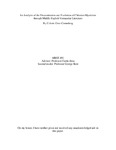| dc.rights.license | In Copyright | en_US |
| dc.creator | Cruz-Carandang, Celeste Aida | |
| dc.date.accessioned | 2011-09-07T15:13:01Z | |
| dc.date.created | 2011 | |
| dc.identifier | WLURG38_CruzCarandang_MRST_2011 | |
| dc.identifier.uri | http://hdl.handle.net/11021/23097 | |
| dc.description | Thesis; [FULL-TEXT FREELY AVAILABLE ONLINE] | en_US |
| dc.description | Celeste Aida Cruz-Carandang is a member of the Class of 2011 of Washington and Lee University. | en_US |
| dc.description.abstract | My thesis examines a total of three works of literature written in Middle English. I believe that Richard Rolle's Meditations on the Passion, the medieval religious lyric I have selected and The Book of Margery Kempe demonstrate a transformation of Christian mystical thought as it had been conceived in the twelfth century. The progression reveals a movement away from the regular clergy's emphasis on spiritual and abstract meditation. With the increasing availability of vernacular religious texts, the laity began to a shift towards the heightened physicality of devotionalism. Rolle's Meditations, as a work written by an individual closely associated with the Church, contains elements consistent with monastic and mendicant mysticism. His use of graphic, albeit visceral, language encourages the reader to create intensely vivid pictures of the Passion story within his own mind. In turn, the meditator does not rely on an object such as a painting or relic; he simply uses his cognitive capacities. Although his physical senses, love for Christ, and emotions provide him with an abstract sense of the Divine, the contemplator does not use them as the vehicle for enlightenment.
In contrast, the reader of the Middle English lyric becomes dependent on his somatic faculties and emotions. Using the vocabulary of the Franciscans, this poem dilute mystical ideology. While Rolle's audience had employed their earthly senses as a primary step in knowing the divine, this lyric utilize them as their only measure. The reader becomes connected to Christ by way of emotional or sensory appeal. Lastly, Margery Kempe demonstrates a blatant misinterpretation of this type of spiritual thought. Her only connection to Christ is through physical means. Her pilgrimage shows her spatial association with him and her need to touch and see relics connected to the saints. Although she claims to have visionary experiences, these divine encounters place her in the position of a lover or mother. She fails to reach the divine enlightenment described by the twelfth century exegetes. [From the Introduction] | en_US |
| dc.description.statementofresponsibility | Celeste Cruz-Carandang | |
| dc.format.extent | 113 pages | en_US |
| dc.language.iso | en_US | en_US |
| dc.rights | This material is made available for use in research, teaching, and private study, pursuant to U.S. Copyright law. The user assumes full responsibility for any use of the materials, including but not limited to, infringement of copyright and publication rights of reproduced materials. Any materials used should be fully credited with the source. | en_US |
| dc.rights.uri | http://rightsstatements.org/vocab/InC/1.0/ | en_US |
| dc.subject.other | Washington and Lee University -- Honors in Medieval and Renaissance Studies | en_US |
| dc.title | An Analysis of the Dissemination and Evolution of Christian Mysticism Through Middle English Vernacular Literature (thesis) | en_US |
| dc.type | Text | en_US |
| dcterms.isPartOf | RG38 - Student Papers | |
| dc.rights.holder | Cruz-Carandang, Celeste Aida | |
| dc.subject.fast | Mysticism in literature | en_US |
| dc.subject.fast | Devotional literature -- Middle English | en_US |
| dc.subject.fast | Rolle, Richard, 1290?-1349 | en_US |
| dc.subject.fast | Book of Margery Kempe (Kempe, Margery) | en_US |
| local.department | Medieval and Renaissance Studies | en_US |
| local.scholarshiptype | Honors Thesis | en_US |
